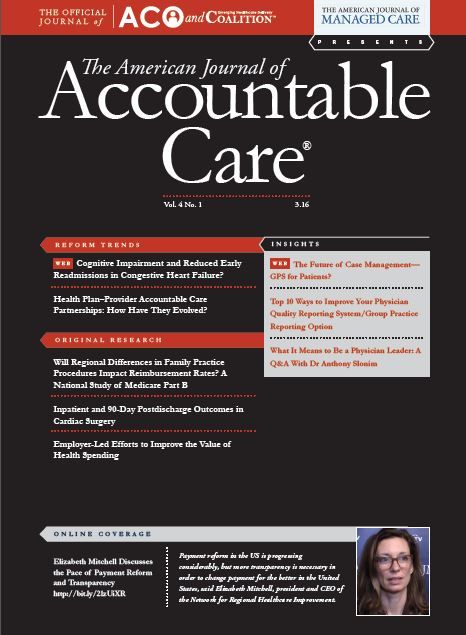Publication
Article
Population Health, Equity & Outcomes
The Future of Case Management - GPS for Patients?
Author(s):
The author discusses the new paradigm for case management services, including inpatient and outpatient responsibilities, in order to succeed in the era of the Affordable Care Act.
In the “good old days,” the hospital had a designated department for utilization management that was supposed to monitor the appropriate utilization of hospital services by physicians for the patients they were caring for. Then, the era of Diagnosis-Related Groups financing brought the change to case management, and hospitals were being compensated by diagnosis, not per-diem. Therefore, the game was to decrease cost by decreasing hospital stay, and maximize documentation to increase presumed severity. Today, we are being told that we are accountable for patients throughout the continuum of care—inpatient, post acute, and outpatient—and are expected to be aware and supervise the entire process. Do we need a GPS for patients to track and guide them through that process?
There is a dramatic change toward healthcare compensation, driven by the Affordable Care Act. Regardless of one’s attitude regarding the law, its goal is to maintain stable healthcare costs and expand access to care. Although there is no argument that the quality of care provided by the healthcare system in the United States is unmatched, this quality is not uniform to all constituents, and costs more than in other comparable countries. Analysis shows that the reason for the excessive cost is multifactorial: one major factor is that based on our compensation system, we manage disease very well, but pay little mind to promoting health. If you ask the butcher what to have for dinner, he will not recommend fish.
Today
Case management was promoted with the idea that by improving utilization of hospital services, we could decrease costs and maximize profit. Case managers were tasked to move patients out of the hospital as quickly as possible—we didn’t care if they returned soon for readmission, because it was another billable event—out of sight, out of mind. Hospitals could negotiate rates with insurers and had no obligation to develop a cost-based accounting system. The entire financial structure was based on charges and working against proposed budgets; the more that was billed, the more the hospital would receive.
We are now moving rapidly toward a value-based healthcare finance system. Whether the end result is global capitation, disease-based episodic payments (bundles), risk contracting, or another similar compensation plan, fee-for-service is going the way of the dinosaur. Networks are going to be responsible for the comprehensive care of the patient, and this serves to magnify the need for health promotion, as healthier people cost less. We will still need to manage the very sick patients, however—which we already do quite nicely—but we will also need to prevent unnecessary complications, minimize unnecessary procedures and diagnostics, improve patient compliance, and increase efficiency.
Tomorrow
The new paradigm will be to keep patients out of the hospital if possible. Once in the hospital, we need to plan the most appropriate postacute care experience, and then monitor and prepare for the outpatient follow-up. Although not rocket science, this is a new concept for most hospitals and healthcare systems. It is clear that case management is becoming a process that will be the lynchpin of any continuum of care program. A mechanism of continually monitoring patients involves the inpatient service, subacute care, and outpatient care; each location requires different skillsets and care plans. In addition, we need to monitor patients differently with specific conditions, such as congestive heart failure, renal disease, and diabetes, which requires a disease-specific care plan model.
Technology will play a major role in this process too. Outpatient monitoring is available for many vital signs, including heart rate, blood pressure, temperature, oxygen saturation, weight, blood sugar, and exercise. These can passively be sent to case managers with alerts for unexpected results. In addition, software is available to promote medication and dietary compliance, with automatic notification of variance. Telehealth will aid in follow-up care, although it will never replace the physical examination. Additionally, new portable technology will allow providers to perform many diagnostic tests in patients’ homes. This may bring back the house call as a valuable tool in the comprehensive care management plan; it is cheaper and more effective to bring the doctor to the patient, rather than use ambulance transport to bring a noncritically ill patient to the emergency department.
Conclusions
The concept of appropriate health care has evolved from managing conditions/episodes of care, to a comprehensive care model. It requires an ability to track patients throughout the continuum and insure the appropriate prevention, education, and intervention needed to minimize unexpected outcomes. The future is not about finding new ways to treat sick people. It is about finding ways to keep people healthy.
Author Affiliations: Population Health Institute for Global Healthcare Experience, Hackensack University Medical Center, Hackensack, NJ.
Source of Funding: None.
Author Disclosures: The author reports no relationship or financial interest with any entity that would pose a conflict of interest with the subject matter of this article.
Authorship Information: Concept and design; drafting of the manuscript; critical revision of the manuscript for important intellectual content.
Send correspondence to: Morey Menacker, DO, Population Health Institute for Global Healthcare Experience, Hackensack University Medical Center, 30 Prospect Ave, Hackensack, NJ 07601. E-mail: MMenacker@HackensackUMC.org.


